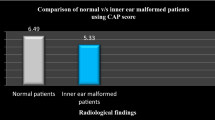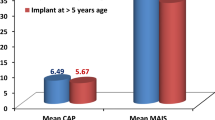Abstract
The aim of the study was to evaluate the factors that act as barriers and delay the process of cochlear implantation in children with congenital profound sensorineural hearing loss. This is a cross sectional observational study in which 154 children with profound sensorineural deafness attending ENT outdoor from Jan 2013 to June 2014 at Sri Aurobindo Institute of Medical College and PG Institute, Indore, were included in the study. Information was taken from the parents of the candidates regarding the reasons for the delay in reporting, the delay in intervention and a detailed history was also taken to evaluate the possible reason for the hearing loss with the help of open ended questions. The most common cause for the delay in reporting was lack of information about the availability of technique and procedure for cochlear implant. Financial constrain was the most common cause for the delay in getting the cochlear implant surgery.
Similar content being viewed by others
References
Pratt, S. R., & Tye-Murray, N. A. (1997). Speech impairment seconday to hearing impairment. In M. McNeil (Ed.)
Kumar S, D’Mello J (2006) Identifying children at-risk for speech and hearing disorder: a preliminary study from Hyderabad, India. Asia Pac Disabil J 17:101–108
World Health Organization deafness and hearing impairment fact sheet February 2014. http://www.who.int/mediacentre/factsheet/ fs300 index
Colletti L (2009) Long-term follow-up of infants (4–11 months) fitted with cochlear implants. Acta Otolaryngol 129(4):361–366
Dettman SJ, Pinder D, Briggs RJ, Dowell RC, Leigh JR (2007) Communication development in children who receive the cochlear implant younger than 12 months: risks versus benefits. Ear Hear 28(2 Suppl):11S–18S
Waltzman SB, Roland JT (2005) Jr. Cochlear implantation in children younger than 12 months. Pediatrics 116(4):e487–e493
Taneja MK (2012) Role of ENT surgeons in the national program for prevention and control of deafness. Indian J Otol 18:119–121
National Sample Survey Organization. Disabled persons in India, NSSO 58th round (July December 2002) Report no. 485 (58/26/1). New Delhi: National Sample Servey Organization, Ministry of Statistics and Programme Implementation, Government of India, 2003
Manrique M, Cervera-Paz FJ, Huarte A, Perez N, Molina M, Garcia-Tapia R (1999) Cerebral auditory plasticity and cochlear implants. Int J Pediatr Otorhinolaryngol 49:S193–S197
Ponton CW, Don M, Eggermont JJ, Waring MD, Kwong B, Masuda A (1996) Auditory system plasticity in children after long periods of complete deafness. NeuroReport 8:61–65
Sharma A, Dorman MF, Spahr AJ (2002) A sensitive period for the development of the central auditory system in children with cochlear implants: implications for age of implantation. Ear Hear 23:532–539
DeCasper AJ, Fifer WP (1980) Of human bonding: newborns prefer their mothers’ voices. Science 208:1174–1176
DeCasper AJ, Lecanuet J-P, Busnel M-C, Granier-Deferre C (1994) Fetal reactions to recurrent maternal speech. Infant Behav Dev 17:159–164
Kuhl PK, Miller JD (1982) Discrimination of auditory target dimensions in the presence or absence of variation in a second dimension by infants. Percept Psychophys 31:279–292
Moon C, Panneton-Cooper R, Fifer WP (1993) Two-day-olds prefer their native language. Infant Behav Dev 16:494–500
Brasel KE, Quigley SP (1977) Influence of certain language and communication environments in early childhood on the development of language in deaf individuals. J Speech Hear Res 20:95–107
Carney AE, Moeller MP (1998) Treatment efficacy: hearing loss in children. J Speech Lang Hear Res 34:565–571
Lederberg AR, Spencer PE (2001) Vocabulary development of deaf and hard of hearing children. In: Clark MD, Marschark M (eds) Context, cognition, and deafness. Gallaudet University Press; Washington, DC, pp 88–112
Mayne AM, Yoshinaga-Itano C, Sedey AL. Expressive vocabulary development of infants and toddlers who are deaf or hard of hearing. Volta Review. 2000a;100:1–28
Mayne AM, Yoshinaga-Itano C, Sedey AL. Receptive vocabulary development of infants and toddlers who are deaf or hard of hearing. Volta Review. 2000b;100:29–52
Pipp-Siegel S, Sedey AL, VanLeeuwen AM, Yoshinaga-Itano C (2003) Mastery motivation and expressive language in young children with hearing loss. J Deaf Stud Deaf Educ 8:133–145
Spencer PE, Meadow-Orlans KP (1996) Play, language, and maternal responsiveness: a longitudinal study of deaf and hearing infants. Child Dev 67:3176–3191
Tomblin JB, Barker BA, Spencer LJ, Zhang X, Gantz BJ (2005) The effect of age at cochlear implant initial stimulation on expressive language growth in infants and toddlers. J Speech Lang Hear Res 48(4):853–867 Erratum in: J Speech Lang Hear Res. 2005 Oct;48(5):1243
El-Hakim H, Levasseur J, Papsin BC, Panesar J, Mount RJ, Stevens D et al (2001) Assessment of vocabulary development in children after cochlear implantation. Arch Otolaryngol Head Neck Surg 127:1053–1059
Hammes DM, Novak MA, Rotz LA, Willis M, Edmondson DM, Thomas JF (2002) Early identification and cochlear implantation: critical factors for spoken language development. Ann Otol Rhinol Laryngol Suppl 189:74–78
Miller GL, Knudsen EI (2003) Adaptive plasticity in the auditory thalamus of juvenile barn owls. J Neurosci 23:1059–1065
Kral A, Hartmann R, Tillein J, Heid S, Klinke R (2000) Congenital auditory deprivation reduces synaptic activity within the auditory cortex in a layer-specific manner. Cereb Cortex 10:714–726
Ponton CW, Moore W, Eggermont JK (1999) Prolonged deafness limits auditory system developmental plasticity: evidence from an evoked potentials study in children with cochlear implants. Scand Audiol 28:13–22
Effects of Deafness on the Young BrainNoise and the Brain, Volume null, Issue null, Pages 120-154 Jos J. Eggermont
Tye-Murray N, Spencer L, Woodworth GG (1995) Acquisition of speech by children who have prolonged cochlear implant experience. J Speech Hear Res 38:327–337
Fryauf-Bertschy H, Tyler R, Kelsay D, Gantz B, Woodworth G (1997) Cochlear implant use by prelingually deafened children: the influences of age at implant and length of device use. J Speech Lang Hear Res 40:183–199
Connor CM, Hieber S, Arts HA, Zwolan TA (2000) Speech, vocabulary, and the education of children using cochlear implants: oral or total communication. J Speech Lang Hear Res 43:1185–1204
Geers AE, Nicholas JG, Sedey AL (2003) Language skills of children with early cochlear implantation. Ear Hear 24:46S–58S
Geers AE (2003) Predictors of reading skill development in children with early cochlear implantation. Ear Hear 24:59S–68S
Svirsky MA, Robbins AM, Kirk KI, Pisoni DB, Miyamoto RT (2000) Language development in profoundly deaf children with cochlear implants. Psychol Sci 11:153–158
Ching TY, Dillon H, Day J et al (2009) Early language outcomes of children with cochlear implants: interim findings of the NAL study on longitudinal outcomes of children with hearing impairment. Cochlear Implants Int 10(Suppl 1):28–32
Niparko JK, Tobey EA, Thal DJ et al (2010) Spoken language development in children following cochlear implantation. JAMA 303(15):1498–1506
Tomblin JB, Barker BA, Spencer LJ, Zhang X, Gantz BJ (2005) The effect of age at cochlear implant initial stimulation on expressive language growth in infants and toddlers. J Speech Lang Hear Res 48(4):853–867
Author information
Authors and Affiliations
Corresponding author
Rights and permissions
About this article
Cite this article
Kothari, S., Keshree, N.K. & Bhatnagar, S. Pediatric Cochlear Implantation—Why the Delay. Indian J Otolaryngol Head Neck Surg 67, 165–169 (2015). https://doi.org/10.1007/s12070-015-0838-3
Received:
Accepted:
Published:
Issue Date:
DOI: https://doi.org/10.1007/s12070-015-0838-3




